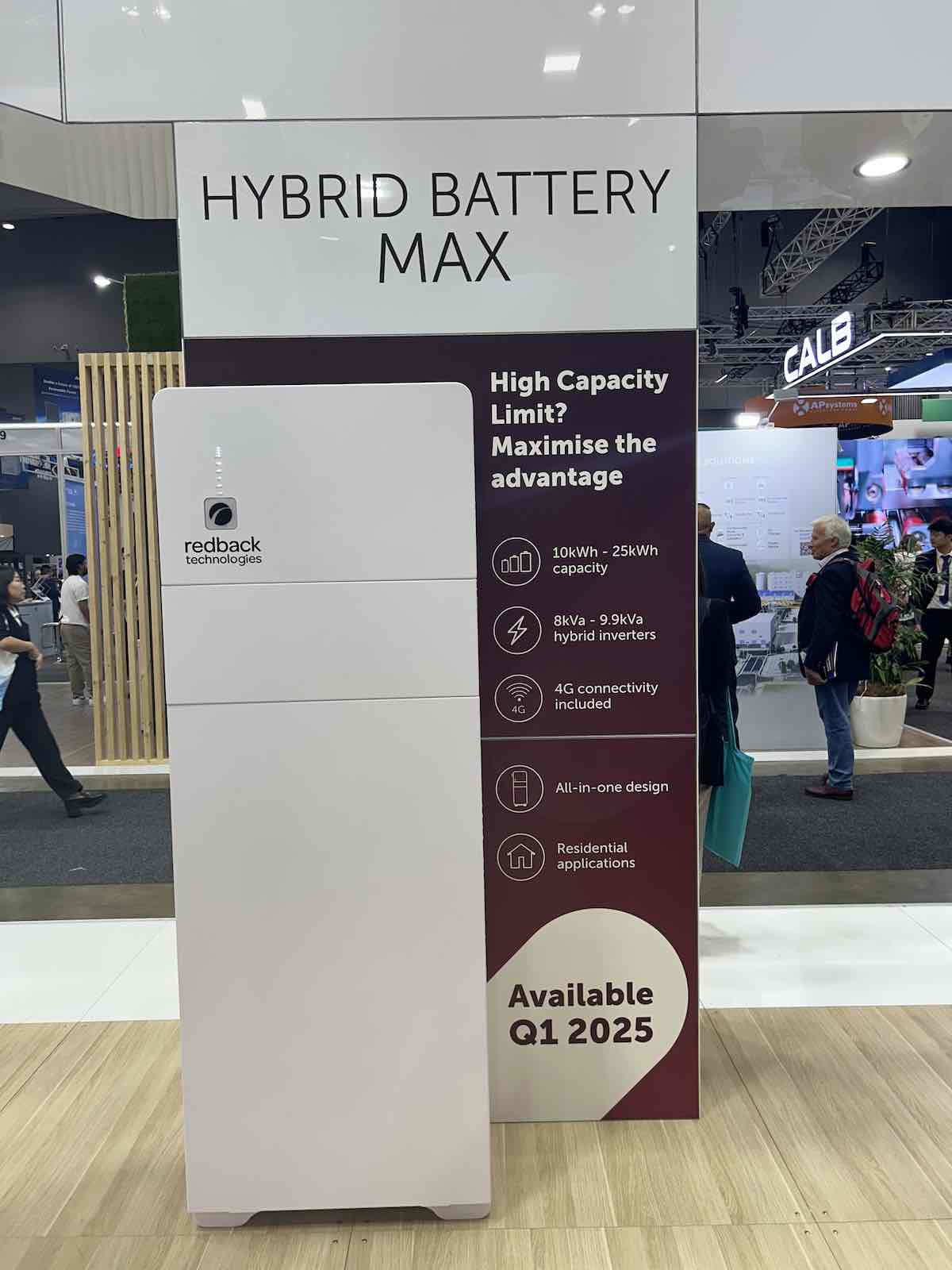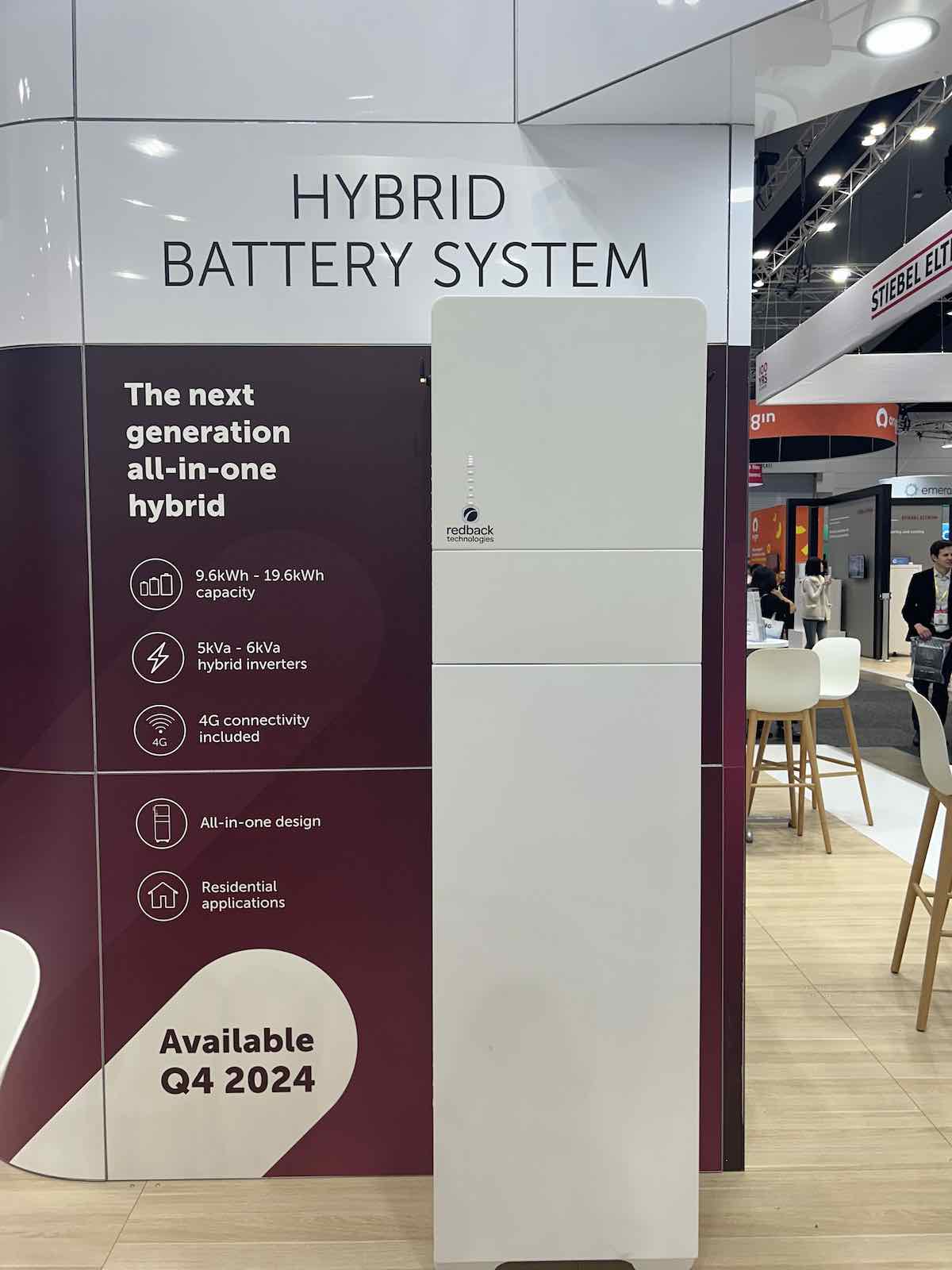
Australian-owned and operated battery and smart inverter outfit Redback Technologies has revealed the specs of its “next generation” of lithium-ion home batteries, including a 10kWh – 25kWh unit that will hit the market in early 2025.
Redback’s new Hybrid Battery Max was on show at the All Energy Australia exhibition and conference in Melbourne last week, looking tall, slim and sleek and promising up to 25kWh of storage for homes.
Alongside it was the smaller-scale Hybrid Battery System, an equally sleek looking unit offering between 9.6kWh and 19.6kWh, with deliveries now underway.
The Hybrid Battery System was first unveiled in March this year at the Smart Energy Conference in Sydney, just days before Redback’s brief stint in voluntary administration was announced.
The company was back in business in May under the control of new owners, Australia Ebon Group, and promising “a reinvigorated and bright future” for Australian-engineered energy storage solutions for homes and businesses.
Redback CEO Adrian Knack says the company will be releasing prices for the two new home batteries in November, ahead of some pre-sales of those units for installation either late December or early January.
“We’re not aiming to be the cheapest unit on the market, but we’re absolutely trying to disrupt the space that we’re in and make people sit up and take notice of Redback again,” Knack told One Step Off The Grid on Tuesday.
Knack says the new batteries have been designed for ease of installation, which can be done in about 15 to 20 minutes from rough-in, and for ease of accessibility for users.
“This means that homeowners, if they need to access [controls], they can just pop the cover off without any tools and get to access it. But then if they close it up, then it just looks nice.”
But he says the biggest change Redback has made to its Gen 3 batteries is in their energy management systems, which – in combination with boosted storage capacity – are specifically designed to take advantage of virtual power plant (VPP) opportunities.
“Oversizing batteries become a real opportunity for households to make some additional money back, particularly if you’re trading on the energy market,” Knack said.
“We just announced that were compatible with [energy retailer] Amber… and that improves your return on investment, because that overcapacity can be supplied into a market at preferential pricing.
“And that’s why we went to … just shy of 20 kilowatt-hours on our new Hybrid Battery Systems. It really creates an opportunity that actually reduces the … time before you’re making money back and then make some profit over that 10 year warranted lifetime of the product.
“So you’re seeing solar feed-in tariffs at three cents, right? But if you’re on a market event, and you’re getting 40c, or even $1 or maybe more per kilowatt-hour … that can actually make a week-worth of exports in a very short amount of time.
“Now that’s not going to happen all the time, but that doesn’t matter, because you have the capacity there to meet your own demand.”
To this end, Redback is also currently working on a prototype of an app that will allow a list of VPP operators to present an offer to the battery owner and, if for the customer to opt in – and out – with one click.
Knack says the idea will be that customers can compare VPPs offerings and fit them to their own energy profiles and needs – as well as match it to their risk profile.
“So if you’re … using open market trading, you can sometimes get burnt by the wholesale price, which means you lose money in a day.
“There will be VPP offerings that are … lower risk and guaranteed return, but maybe they don’t have the big upside that you get with Amber.
“And what we’re going to be trying to do is have some smarts in the background which, say, based on your usage, make certain recommendations to you.”
Other specs of the Hybrid Battery Max unit includes an inverter with a maximum output of power up to 9.9kVa. Both units offer back-up power in the case of a grid outage.
The units stand at 1800mm in height (slightly shorter than the Hybrid Battery System), with a width of 661mm and depth of 380mm. The batteries can be installed inside or outside (temperature rated between -40°C to 60°C) and have a 10-year warranty.
The new batteries also come with in-built smart meters and 4G/5G dongles, thus giving them independent wi-fi access, instead of connecting via the existing home wi-fi.
“One of the biggest challenges when you’re running a VPP is assets disappearing offline due to someone changing their password or unplugging a network cable, or something like that,” Knack says.
“So we sort of solve all those problems by just providing 4G access in the box. So you just turn it on, press the “enable” button, and away you go.
“And that’s the experience that we want in the market moving forward, because it guarantees connection, it guarantees that improvement to the rate of return of the asset, and it also means that the installer spends less time on site, so they’re happy, and it’s more reliable overall, which makes everybody happy.
“I think reliability … is really going to be key moving forward. There’s lots of stuff on the market now, we saw that at All Energy.
“But the [batteries] that are going to remain in the market for the longest are the ones … that show themselves to be reliable systems for homeowners.”

Sophie is editor of One Step Off The Grid and editor of its sister site, Renew Economy. Sophie has been writing about clean energy for more than a decade.


